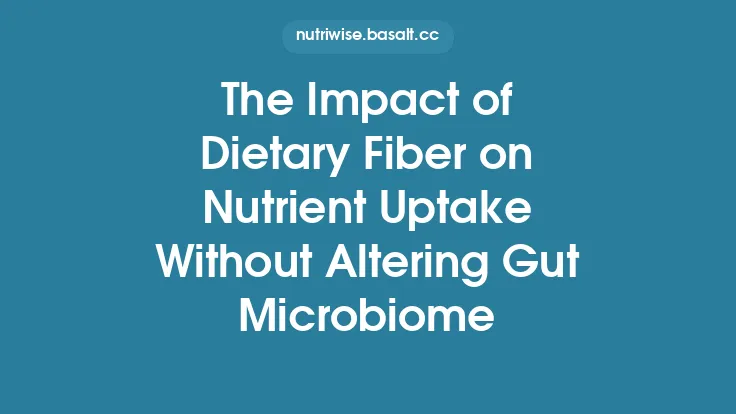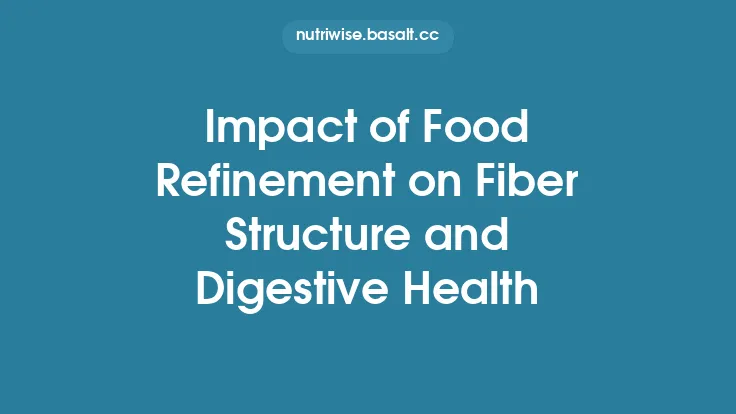The past decade has witnessed an unprecedented surge in longitudinal nutrition research, and among the most compelling findings are those linking sustained consumption of fiber‑rich diets to the stability of the gut microbiome. Unlike short‑term feeding trials that capture only transient shifts, decade‑long studies allow researchers to observe how dietary patterns shape microbial ecosystems over time, revealing patterns of resilience, functional redundancy, and host‑microbe co‑adaptation that are essential for long‑term health.
1. Why Gut Microbiome Stability Matters
The gut microbiome is a dynamic community of bacteria, archaea, viruses, and fungi that collectively perform metabolic, immunological, and barrier‑protective functions. Stability—defined as the capacity of the community to maintain its composition and functional output despite environmental perturbations—has emerged as a key indicator of a healthy gut ecosystem. Stable microbiomes tend to:
- Preserve short‑chain fatty acid (SCFA) production, especially butyrate, which fuels colonocytes and modulates inflammation.
- Maintain colonization resistance against opportunistic pathogens.
- Support balanced immune signaling, reducing chronic low‑grade inflammation.
- Ensure metabolic flexibility, allowing the host to adapt to dietary fluctuations without dysbiosis.
Longitudinal data suggest that individuals with a stable, fiber‑responsive microbiome experience fewer gastrointestinal complaints, lower incidence of inflammatory conditions, and more consistent metabolic markers, even when other lifestyle factors vary.
2. Defining “Fiber‑Rich” in Long‑Term Studies
Fiber is a heterogeneous group of non‑digestible carbohydrates, broadly classified into:
| Category | Typical Sources | Fermentability | Primary Metabolites |
|---|---|---|---|
| Soluble, highly fermentable (e.g., inulin, pectin) | Chicory root, apples, oats | High | Acetate, propionate, butyrate |
| Soluble, moderately fermentable (e.g., β‑glucan) | Barley, oats | Moderate | SCFAs, lactate |
| Insoluble, low fermentability (e.g., cellulose) | Wheat bran, whole‑grain cereals | Low | Minimal SCFAs, increased stool bulk |
| Resistant starch (type 2–4) | Cooked‑and‑cooled potatoes, legumes | Variable | SCFAs, especially butyrate |
In decade‑long interventions, researchers typically quantify fiber intake using validated food frequency questionnaires (FFQs) calibrated against 24‑hour recalls and, when possible, biomarkers such as plasma short‑chain fatty acid concentrations or fecal microbial gene counts (e.g., *butyryl‑CoA:acetate CoA‑transferase*).
3. Study Designs that Capture Decadal Dynamics
3.1 Cohort Selection and Baseline Characterization
- Population: Adults aged 25–55 at enrollment, free of chronic gastrointestinal disease.
- Baseline microbiome profiling: Shotgun metagenomics to assess taxonomic composition, functional gene repertoires, and strain‑level diversity.
- Dietary assessment: Multi‑day weighed food records for 7 consecutive days, repeated annually.
3.2 Intervention Strategies
- Prescriptive fiber increase: Participants receive individualized counseling to achieve ≥30 g/day of total dietary fiber, emphasizing a mix of soluble and insoluble sources.
- Control group: Maintains usual diet; receives general nutrition education without specific fiber targets.
- Adherence monitoring: Quarterly digital food logs, periodic 24‑hour recalls, and fiber biomarker checks.
3.3 Sampling Frequency
- Microbiome: Stool samples collected at baseline, 6 months, 1 year, and then annually.
- Metabolomics: Fecal SCFA quantification and plasma metabolite panels at the same time points.
- Host outcomes: Inflammatory markers (e.g., C‑reactive protein, fecal calprotectin), gut barrier integrity (e.g., serum zonulin), and self‑reported gastrointestinal symptom scores.
4. Core Findings Across Decade‑Long Trials
4.1 Taxonomic Shifts Toward Fiber‑Degrading Guilds
- **Enrichment of *Bifidobacterium and Faecalibacterium* spp.:** These genera possess extensive carbohydrate‑active enzyme (CAZyme) repertoires for fermenting oligosaccharides and resistant starches.
- **Stabilization of *Ruminococcaceae and Lachnospiraceae* families:** Their relative abundances become less volatile over time, correlating with higher SCFA output.
4.2 Functional Resilience and Redundancy
- Increased abundance of glycoside hydrolase families GH13, GH43, and GH95: These enzymes degrade a broad spectrum of plant polysaccharides, providing functional redundancy that buffers against short‑term dietary lapses.
- Maintenance of butyrate‑producing pathways: Metagenomic pathway analysis shows sustained expression of the *butyrate synthesis* module (via the acetyl‑CoA pathway) even when fiber intake dips temporarily.
4.3 Microbial Network Stability
- Higher modularity and clustering coefficients: Co‑occurrence networks derived from longitudinal data reveal tighter, more cohesive clusters among fiber‑degrading taxa, indicating robust ecological interactions.
- Reduced “hub turnover”: The set of keystone species (nodes with high betweenness centrality) remains largely unchanged across the decade, suggesting a mature, stable ecosystem.
4.4 Host‑Microbe Metabolic Coupling
- Consistent SCFA profiles: Participants with stable microbiomes maintain fecal butyrate concentrations of 10–15 mmol/kg, whereas those with fluctuating microbiomes show greater variability (5–20 mmol/kg) and occasional dips below 5 mmol/kg.
- Improved gut barrier markers: Serum zonulin levels decline modestly (≈10 % on average) in the high‑fiber group, aligning with reduced intestinal permeability.
5. Mechanistic Insights: How Fiber Drives Stability
5.1 Substrate Diversity as an Ecological Buffer
A diet rich in varied fiber types supplies a continuous stream of fermentable substrates, preventing any single microbial lineage from dominating. This “resource partitioning” promotes coexistence and reduces competitive exclusion.
5.2 Cross‑Feeding Interactions
- Primary degraders (e.g., *Bifidobacterium*) break down complex polysaccharides into oligosaccharides and monosaccharides.
- Secondary fermenters (e.g., *Eubacterium rectale*) convert these intermediates into butyrate.
- Tertiary consumers (e.g., *Akkermansia muciniphila*) utilize mucin-derived sugars, which are indirectly supported by SCFA‑mediated mucosal health.
These cascades create a tightly knit metabolic web that stabilizes community function even when external inputs fluctuate.
5.3 Host‑Mediated Feedback Loops
SCFAs act on G‑protein‑coupled receptors (FFAR2/3) in enteroendocrine cells, modulating gut motility and secretion. This feedback influences transit time, which in turn affects microbial growth rates and community composition, reinforcing a stable state.
6. Translational Implications
6.1 Clinical Relevance
- Preventive strategy: Maintaining a fiber‑rich diet could be a non‑pharmacologic approach to preserve gut microbiome stability, potentially lowering the risk of dysbiosis‑related conditions such as irritable bowel syndrome and inflammatory bowel disease.
- Adjunct to therapy: For patients undergoing antibiotics or other microbiome‑disrupting treatments, a high‑fiber regimen may accelerate recovery of a stable microbial community.
6.2 Public Health Messaging
- Emphasize diversity: Recommendations should highlight not just total fiber quantity but also a mix of soluble, insoluble, and resistant starch sources.
- Long‑term adherence: Educational programs that integrate cooking skills, seasonal produce selection, and gradual fiber ramp‑up can improve sustained intake.
7. Limitations of Current Decadal Research
| Issue | Description | Potential Mitigation |
|---|---|---|
| Cohort attrition | Drop‑out rates increase over ten years, potentially biasing results toward more health‑conscious participants. | Use intention‑to‑treat analyses and imputation methods; recruit larger initial samples. |
| Dietary assessment error | Self‑reported intake can be inaccurate, especially over long periods. | Incorporate objective biomarkers (e.g., plasma alkylresorcinols for whole‑grain intake) and periodic 24‑hour recalls. |
| Geographic and ethnic homogeneity | Many studies are conducted in Western, urban populations. | Expand to multi‑center, globally diverse cohorts to assess generalizability. |
| Microbiome sequencing depth | Shallow sequencing may miss low‑abundance but functionally important taxa. | Adopt deep shotgun metagenomics and metatranscriptomics for functional resolution. |
| Confounding lifestyle factors | Physical activity, sleep, and medication use also influence microbiome stability. | Collect comprehensive lifestyle data and apply multivariate modeling. |
8. Future Directions
- Integrative Multi‑omics: Combine metagenomics, metatranscriptomics, metabolomics, and host epigenomics to map causal pathways linking fiber intake to microbial stability and host health.
- Strain‑Level Tracking: Use long‑read sequencing (e.g., Oxford Nanopore) to follow specific fiber‑degrading strains over time, assessing persistence and horizontal gene transfer events.
- Personalized Fiber Recommendations: Develop predictive models that incorporate baseline microbiome composition to tailor fiber type and amount for optimal stability.
- Intervention Timing: Investigate whether critical windows (e.g., early adulthood vs. mid‑life) exist where fiber intake has a disproportionate impact on long‑term microbiome resilience.
- Ecological Modeling: Apply dynamical systems and network theory to simulate how perturbations (e.g., antibiotics, diet shifts) affect stability trajectories under different fiber regimes.
9. Practical Guidance for Sustaining a Fiber‑Rich Diet
| Strategy | Example Foods | Tips for Consistency |
|---|---|---|
| Mix soluble and insoluble fibers | Oats, legumes, berries, nuts, whole‑grain breads, carrots, leafy greens | Pair a soluble source (e.g., oatmeal) with an insoluble side (e.g., raw carrots) at each meal. |
| Include resistant starch | Cooked‑and‑cooled potatoes, rice, pasta; green bananas; lentils | Prepare batch‑cooked grains, refrigerate, and reheat to increase resistant starch content. |
| Diversify sources weekly | Rotate between beans, peas, whole‑grain cereals, nuts, seeds, and fruit varieties | Use a “fiber rotation calendar” to ensure at least five distinct sources per week. |
| Gradual increase | Add 5 g of fiber per week until target is reached | Start with a fiber supplement (e.g., inulin) if needed, then transition to whole foods. |
| Hydration | Water, herbal teas | Increase fluid intake proportionally to fiber to avoid constipation. |
| Mindful cooking | Light steaming, minimal processing | Preserve fermentable fibers by avoiding over‑cooking vegetables. |
10. Concluding Perspective
A decade of rigorous, longitudinal research converges on a clear message: sustained consumption of a diverse, fiber‑rich diet cultivates a gut microbiome that is not only compositionally robust but also functionally resilient. This stability underpins a host of health benefits that extend beyond the gastrointestinal tract, reinforcing the central role of dietary fiber as a cornerstone of long‑term nutritional wellness. As the field moves toward precision nutrition, the insights gleaned from these long‑term studies will be instrumental in designing interventions that harness the microbiome’s capacity for adaptation, ultimately fostering a healthier, more balanced human ecosystem.





